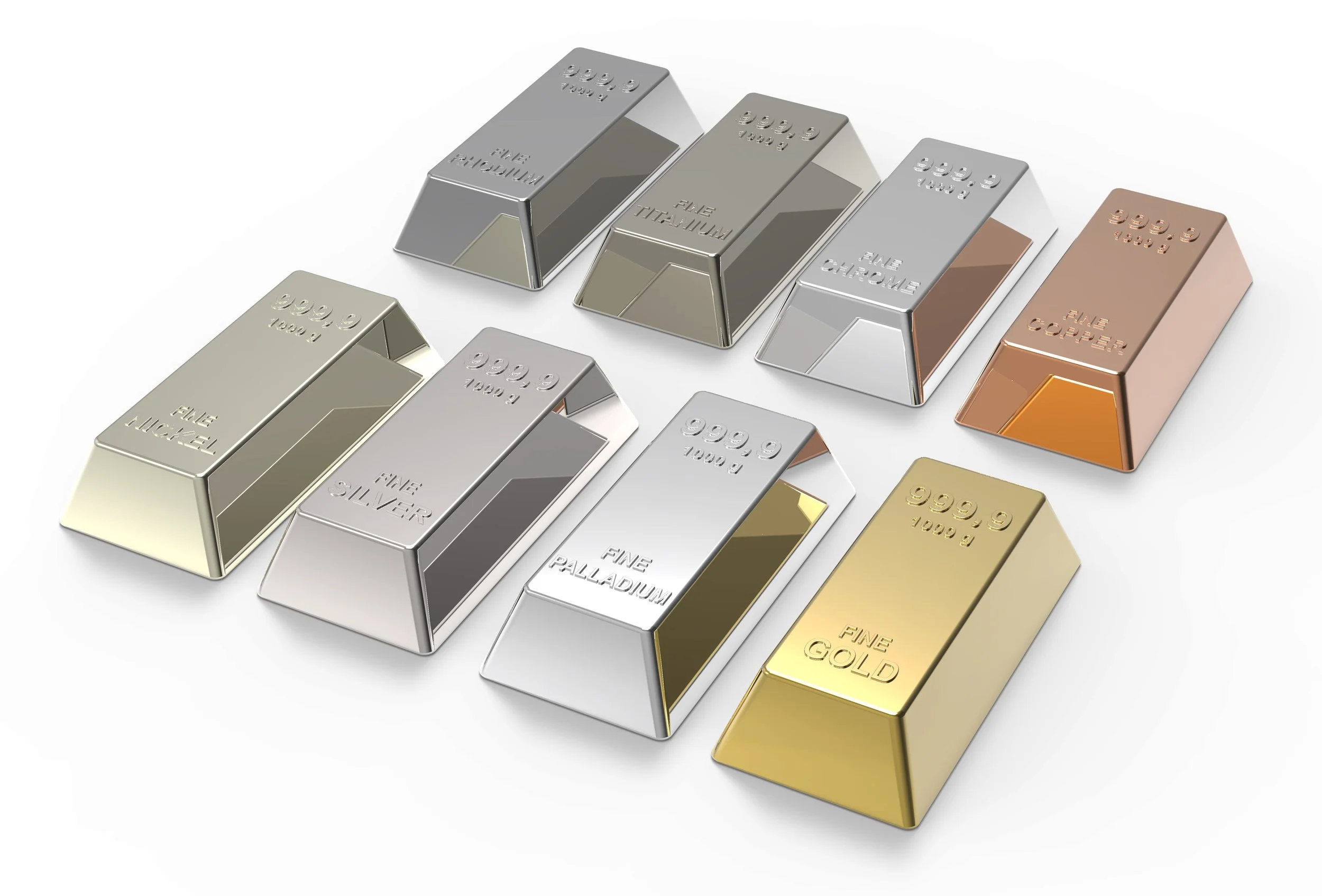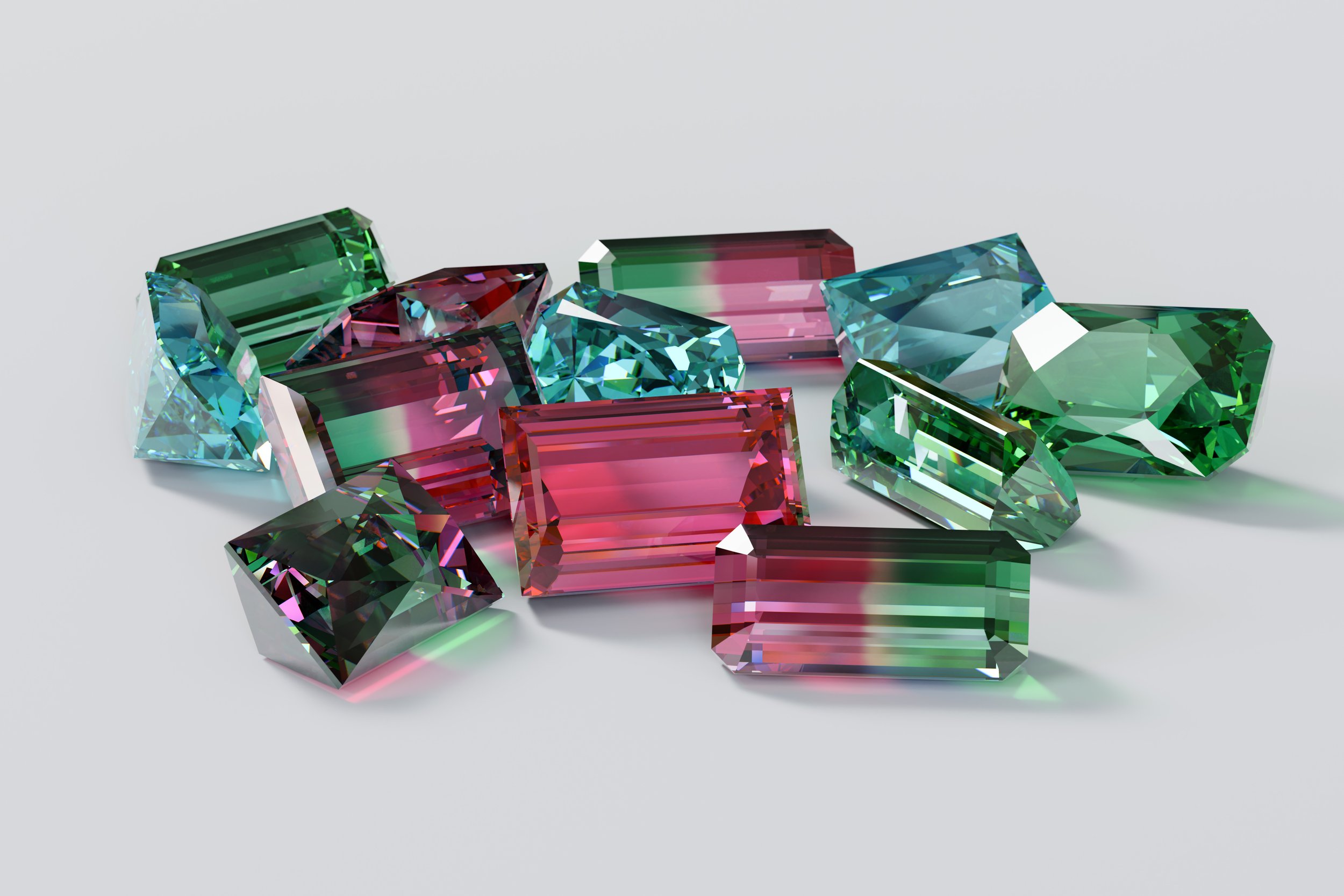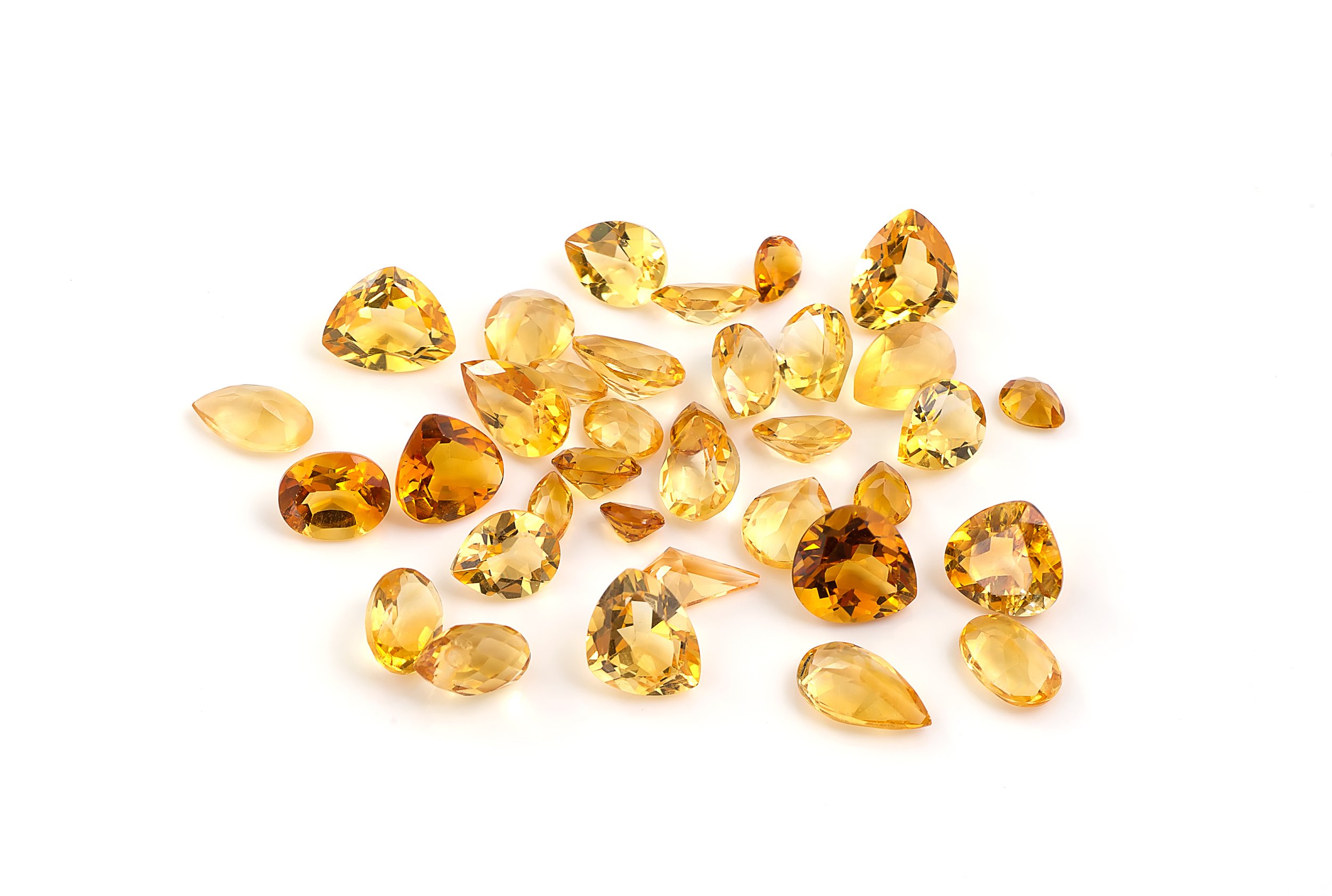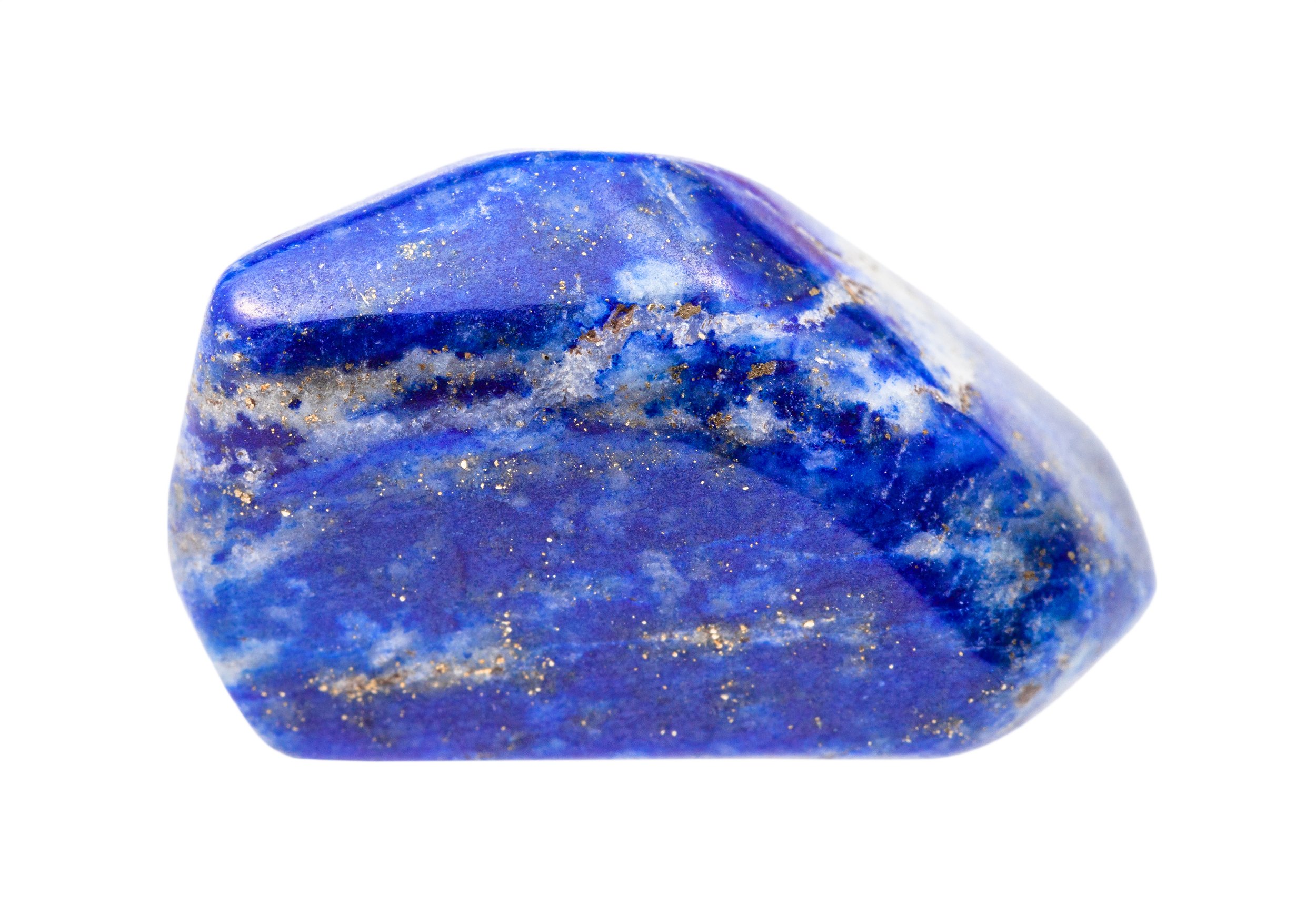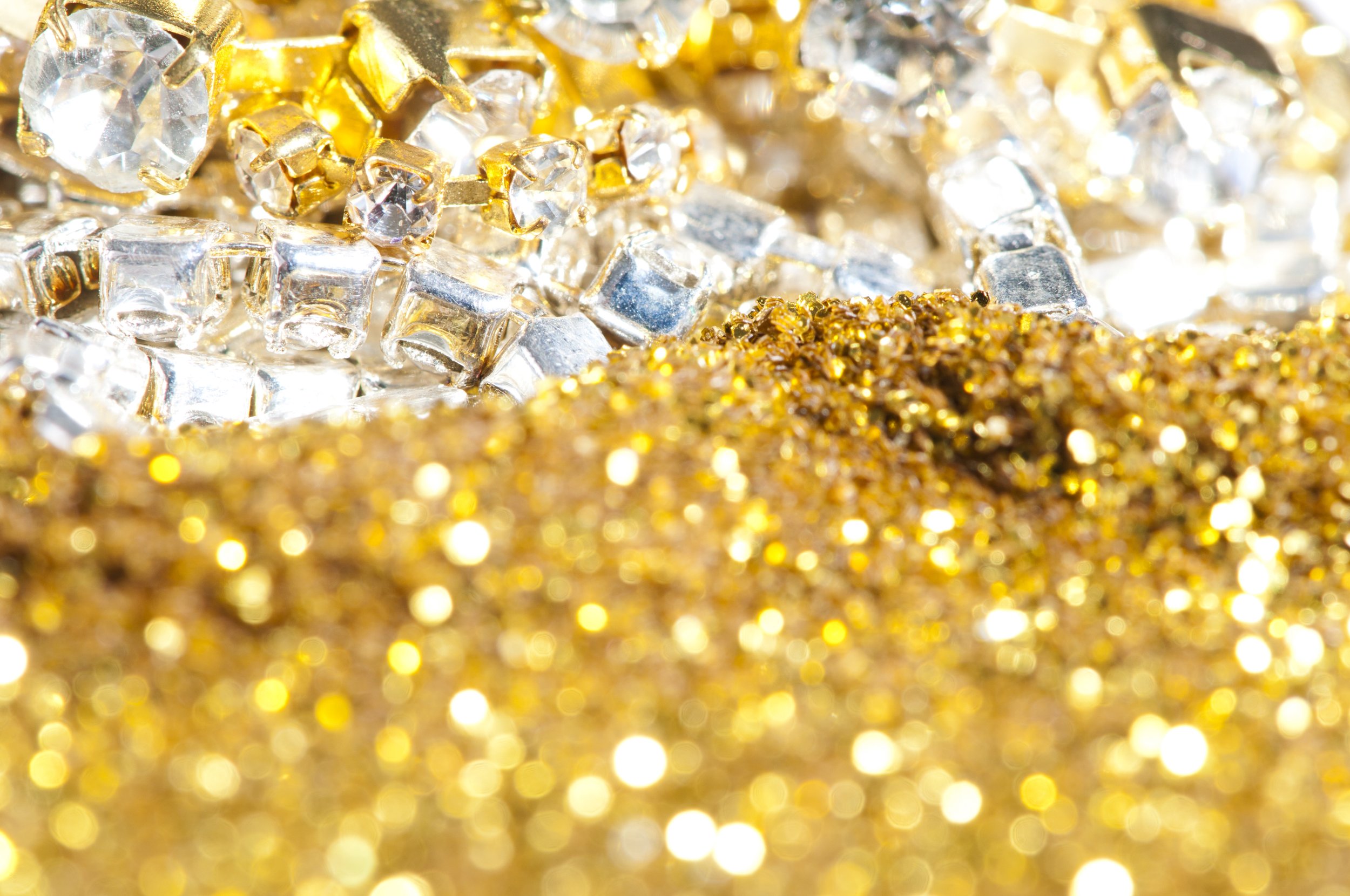
METAL AND GEMSTONES
Metal
GOLD
A literal definition might call GOLD a precious metal, but it has always been much more than just that. The most malleable and ductile of all precious metals, Gold is resistant to rust, tarnish and corrosion, which makes it the most important metal in jewelry making. Because pure gold is too soft for everyday use, it is alloyed with various metals to give it strength, durability and mixed with other metals to create a plethora of colors. To understand gold jewelry best, we should first look at its purity. The purity of gold is measured in 'karats' or 'k' and signifies the per cent of pure gold in the alloy.
-
Pure 100% gold is 24 karat by definition, hence to determine the amount of pure gold in a single piece, a piece's karat is divided by 24. It is usual to create jewelry pieces with this amount of gold, 24k is actually quite soft, and can’t withstand the daily wear and tear we put on our jewelry. Instead, it is mixed with other metals to add strength and alter its color. This resulting mixture is known as an alloy.
-
Refers to an alloy of gold that contains 18 parts of gold or is composed of 75% gold, which is alloyed with other metals to make it strong enough for everyday wear. It is the standard karatage used in fine jewelry in Europe. The higher karat gold tends to take on a rich depth of color not found in the lower karat weights.
-
Refers to an alloy of gold that contains 14 parts gold or at least 58.3% pure gold by weight and 41.7% of other metals. The balance is made up of other metals to give it strength. It is the standard karatage used in fine jewelry in the US because of the right balance of color and durability.
-
Refers to an alloy of gold that contains 10 parts of gold or at least contains 41.7% of gold. 10 karat gold jewelry is sturdy, does not scratch easily and not too soft. The higher the karat, the softer and brittle it becomes. It is a tough and quite often rings are made with 10k gold because it stands up so well to the everyday abuse it gets on your hands.
-
YELLOW GOLD is typically alloyed with copper, silver, and zinc.
ROSE GOLD alloys have the same gold content as their yellow gold counterparts. But they get their rosy color by being mixed with a larger portion of copper than silver and zinc.
The world of WHITE GOLD gets more complicated since there are multiple options. The main points to consider when choosing between white gold alloys are metal allergies, color preference and maintenance.
BLACK GOLD is mixed with another metal such as cobalt, usually to the ratio of 3 parts gold to 1 part metal. However, although this is called an alloy it is not really one. The black layer is only on the surface unlike other alloys where the metals are combined.
STERLING SILVER
Sterling Silver, also called as fine Silver or 925 Silver is an alloy of Silver containing 92.5% by mass of Silver. Silver is a precious metal always associated with success, glamour and wealth. It is ductile and malleable, which means it can be beaten into wire or sheets therefore making it ideal for jewelry use and intricate designs. The best way to keep your Silver looking great is to wear it as this stops it oxidizing with the air and tarnishing. To clean Silver, use polishes which are formulated specifically to remove tarnish. When not worn, it should be stored in a soft pouch to prevent scratching. To maintain the shine, contact with perfume, hairspray and cleaning products must be avoided.
PALLADIUM
Palladium is a member of the Platinum Metals Group (PMG) on the periodic table and is more rare than gold. It's a naturally occurring grayish-white metal, just a touch darker than platinum. It’s typically used in an alloy that is 95% pure palladium and mixed with another PMG member: ruthenium.
Palladium is great for jewelry production. Its malleability makes it excellent for holding diamonds in place, while still being a very durable metal that resists scratches better than platinum or white gold. Its naturally white color means there’s no need to rhodium plate. Palladium is also hypoallergenic.
Palladium has a lower density than other precious metals, meaning a piece of the same size and shape will be lighter in palladium than in platinum or white gold. This makes it a great candidate for creating wedding bands that feel lightweight and comfortable.
Over the past few years the price of palladium has skyrocketed. Jewelry created in palladium was once an affordable alternative to 14k gold, but now it rivals the price of platinum.
Its purity, hypoallergenic quality and lower maintenance are the main arguments for choosing this alloy over white gold. Its lower density and slightly lower price tag are typical reasons one would choose this alloy over platinum.
PLATINUM
Platinum is a rare precious metal which is naturally grayish white in color. Like palladium, platinum is hypoallergenic and needs no rhodium plating.
Platinum has been used in precious jewelry for centuries. It polishes to an excellent shine and is very malleable, so it is great for setting stones in intricate designs. Platinum is also the most dense of the precious metals, making it a sturdy metal for intricate filigree designs. This density also lends itself to setting large diamonds since prongs made of platinum are sturdier than ones made of white gold.
The malleability of platinum allows the metal's finish to develop a patina over time. Instead of losing metal when scratched, the surface of platinum is only displaced, causing a rich matte finish over time that can easily be re-polished or re-textured down the road without removing metal.
Platinum is truly an heirloom quality metal. Its physical properties make it a coveted metal for jewelry designs that last for generations. While it may be the most expensive of the precious metals, platinum jewelry is worth considering for its rarity, purity, and density.
RHODIUM
Rhodium has been used as a coating for jewelry and silverware since the 1930s, one of six PGMs, is a silver-white metallic element that is highly reflective, hard and strongly resistant to corrosion. It is considered the rarest and most valuable precious metal in the world — far more so than gold or platinum. Rhodium gives off one of the best sheens achievable
Rhodium plated means jewelry made from a base metal of gold, silver, or other alloy that is coated in a thin layer of rhodium for extra strength and luster. Jewelry plated in rhodium is shinier and more durable than other metals. Rhodium plating does not scratch, dent, or corrode and retains its luster.
Black can be added to rhodium by binding black ink to the metal during plating. Black rhodium plating has an edgy, mysterious look, but it is expensive to maintain. Rhodium plating must be touched up occasionally, and requesting black rhodium replating adds to the cost.
Gemstone
Minerals is a creation of Mother Nature, have great strength and energy and, therefore, have been studied and used as true amulets for many years. All natural stone are unique, and meets different tastes. Let's get to know a little bit of some stones.
AMETHYST
Birthstone: February
Colors: Naturally purple, can present many varieties of shades. It can go from a light lilac to an intense purple.
Use: It is good for overall protection, and physical, emotional and mental balance. It's a highly serene and spiritual gemstone.
Care: Amethyst is best cleaned with warm water and dry with soft cloth. May fade over time exposure prolonged to bright light. Always avoid harsh detergents, and never clean your jewelry with solvents such as alcohol, acetone, acid or paint thinner.
RHODOLITE
Birthstone: January or June
Colors: A pink/red and purple variety of garnet.
Use: Rhodolite means in Greek "Rose Stone” is a stone of inspiration, intuition, love, and emotional healing
Care: : Rhodolite is best cleaned with warm water and mild detergent, scrub with soft brush and let dry on a soft cloth. Never use heat to clean rhodolite since this can ruin the color of the stone. Avoid prolonged exposure to bright light as some stones may fade. Always avoid harsh detergents, and never clean your jewelry with solvents such as alcohol, acetone, acid or paint thinner.
IOLITE
Birthstone: Natural birthstone for people born in winter solstice i.e. from 21st December to 19th January.
Colors: The name iolite comes from ios, the Greek word for violet. Iolite is commonly known as "water sapphire" in its deep blue sapphire color. Ranges in colour from light to dark blue, and even violet. However, the stone is also known to occur in different hues including green, brown, yellow and grey.
Use: A ‘Vikings’ Compass’ stone that carries the spirit of journey, dreams, intuition, exploration and illumination. Many people think of iolite as a guiding stone that helps you to move both physically and spiritually from one realm into another. It is lying/yang balance, aura, travel, shamanic visions and journeys.
Care: Iolite is best cleaned with warm water and mild detergent, scrub with soft brush and let dry on a soft cloth. Avoid prolonged exposure to bright light as some stones may fade. Always avoid harsh detergents, and never clean your jewelry with solvents such as alcohol, acetone, acid or paint thinner.
AQUAMARINE
Birthstone: March
Colors: A blue and greenish blue variety of beryl.
Use: A "breath stone" is a stone of courage. In latin aqua marinus, meaning “water of the sea,” is a Water element stone, powerful for cleansing the emotional body and opening communication.
Care: Aquamarine is best cleaned with warm water and mild detergent, scrub with soft brush and rinse, make sure all of the soap and residue are off of the jewelry. Let dry on a soft cloth. Avoid prolonged exposure to bright light may alternate the natural color. Always avoid harsh detergents, and never clean your jewelry with solvents such as alcohol, acetone, acid or paint thinner.
APATITE
Birthstone: It is a natural birthstone during February 19 – March 19
Colors: The neon blues may be the most famous of the apatites but this gemstone comes in a whole range of colors, green, brown, softer or darker blues, yellow, violet and even colorless.
Use: The “Stone of Intuition and Enlightenment" Apatite is a stone that mystically can stimulate the thoughts and ideas. It is said to help you maintain focus, learn, concentrate effectively, think clearly, and communicate better.
The name Apatite comes from the Greek word "apate" that means "to deceive" in allusion to its similarity to other more valuable minerals such as olivine, peridot and beryl.
Care: Apatite is best cleaned with warm water and mild detergent, scrub with soft brush and rinse, make sure all of the soap and residue are off of the jewelry. Let dry on a soft cloth. Avoid prolonged exposure to bright light as some stones may fade. Always avoid harsh detergents, and never clean your jewelry with solvents such as alcohol, acetone, acid or paint thinner.
DIAMOND
Birthstone: April
Colors: Everybody knows diamond for the white and shine stone, but diamonds are available in black and shades of 12 base colors. This includes red, yellow, orange, green, blue, pink, purple, brown, violet and gray.
Use: Symbol of eternal love. The word "diamond" comes from the Greek "adamas" and means "unconquerable" or "indomitable", living up to the fact that the stone is extremely hard and resistant. Thus, the gem gives the idea of eternity, being widely used in engagement rings as it represents affection and fidelity.
Care: Diamond is best cleaned with warm water and mild detergent, scrub with soft brush and rinse, make sure all of the soap and residue are off of the jewelry. Let dry on a soft cloth. Always avoid harsh detergents, and never clean your jewelry with solvents such as alcohol, acetone, acid or paint thinner.
EMERALD
Birthstone: May
Colors: It can be slightly bluish and the most desirable vivid green.
Use: The origin of the term emerald came from the word “smaragdos” in Greek, means “green stone”. Also according to the Greeks, the emerald was known as "the green goddess of all stones", for this reason it has a strong connection with Aphrodite.
The Egyptians adopted the term "Stone of Love", they believed that emeralds were able to protect against everything that's negative, whether energies or spirits. They were also used by those who sought to understand and even predict the future.
The Jews, on the other hand, sought to obtain a greater connection with the divine through the stone. Therefore, it was very common to find this stone in churches, where religious used necklaces made with it.
The Romans used the crystal to honor Venus, in turn, sought to transform all sadness into joy, health and peace. Not only that: sailors believed that, with it, they would have a calmer and safer voyage.
Starting in the 18th century, people came to see the emerald as a type of protective amulet. Thus, poisons would not reach individuals who was wering any type of accessory with the stone. At the same time, women who wanted to get pregnant or have a good birth also wore necklaces with this crystal.
It can be seen, then, that over time, the emerald has played an important role in different cultures, especially because of its mystical characteristics, which not only offer us protection, but also security, vitality and health.
Care: Emerald is best cleaned with warm water and mild detergent, scrub with soft brush and rinse, make sure all of the soap and residue are off of the jewelry. Let dry on a soft cloth. Ultrasonic vibrations can weaken already-fractured stones, and hot steam can cause oil or unhardened resin to sweat out of fractures. Store your jewelry away from direct sunlight and from extreme heat. Always avoid harsh detergents, and never clean your jewelry with solvents such as alcohol, acetone, acid or paint thinner.
RUBY
Birthstone: July
Colors: Rubies are by definition a medium to dark tone, primarily colored red. This means light colorsin rubies are not rubies, but pink sapphires.
Use: Known as a stone that has a power of protection, for bringing vibrations that act as a shield, Ruby is considered an amulet capable of warding off negative energies.
This stone is also related to strength and courage to achieve goals, functioning as a stimulus for leadership capabilities.
The ancient Romans even thought that the Ruby was capable of bringing much needed courage and fear to face the adversities of that time.
In addition to the ancient Romans, the Greeks also venerated this stone and considered it the most important of all precious stones. They believed that Ruby was the blood of the earth and that it represented a source of strength, love and above all life.
Ruby name is from the Latin “rubeu” which means “red”. According to some stories, from this region that has the tradition of extracting this stone, the first Ruby was found in Siri Lanka.
There are many legends surrounding this stone, among which we have the fact that it has an internal flame that guarantees a sacred character. This is why, Ruby is present in many religions such as Christianity, Buddhism and Hinduism.
Even Hindus believed that Ruby was able to preserve the health of the body and mind, removing negative thoughts, controlling love desires and promoting reconciliations in disputes.
Its red color, which represents passion, enthusiasm, strength and protection, makes this stone also used in the graduation ring of the course of justice officers, as well as firefighters.
Care: Ruby is best cleaned with warm water and mild detergent, scrub with soft brush and rinse, make sure all of the soap and residue are off of the jewelry. Let dry on a soft cloth. Avoid prolonged exposure to bright light as some stones may fade. Always avoid harsh detergents, and never clean your jewelry with solvents such as alcohol, acetone, acid or paint thinner.
PERIDOT
Birthstone: August
Colors: Naturally green, can present many varieties of shades, it can vary from yellowish green to greenish yellow to brownish green.
Use: A "feel better” stone that is good for the ego and mental health. Offers protection against difficulties and negativity from outside influences.
Care: Peridot is sensitive to heat, acids, ammonia, and hot waters. It best cleaned with water and dry with soft cloth. Always avoid harsh detergents, and never clean your jewelry with solvents such as alcohol, acetone, acid or paint thinner.
SAPPHIRE
Birthstone: September
Colors: The most popular e desirable is the intense black-blue sapphire, other than this, there are a wide variety of colors: light blue, colorless, pink, orange, yellow, green, purple, violet, black. The only colour that sapphires do not come in is red. That’s because gemstones formed from red corundum are called rubies.
Use: Sapphire is a "record-keeper” which makes it valuable for connecting to spiritual wisdom, fulfillment of ambitions, dreams and goals.
Care: The best way to clean your sapphire jewelry is with warm soapy water and a soft brush, avoiding soaking the stone. Always avoid harsh detergents, and never clean your jewelry with solvents such as alcohol, acetone, acid or paint thinner.
TOURMALINE
Birthstone: October
Colors: They can be green, blue, or yellow, pink to red, colorless or color-zoned.
Use: Tourmaline is believed to promote inspiration and happiness, creativity and build self-confidence among its users. It's also used to balance yin-yang energies, as it's considered a physical bridge to the spiritual.
Care: Tourmaline is best cleaned with warm water and mild detergent, scrub with soft brush and rinse, make sure all of the soap and residue are off of the jewelry. Let dry on a soft cloth. Avoid prolonged exposure to bright light as some stones may fade. Always avoid harsh detergents, and never clean your jewelry with solvents such as alcohol, acetone, acid or paint thinner.
-
In 1989, exceptionally brightly colored tourmalines were discovered in the state of Paraíba, Brazil. The stone has intense neon blue color to the presence of copper, an element that has never been observed in tourmalines before.
Paraíba Tourmaline is a very rare stone that has an extremely high vibration capable of connecting us with the wisdom.
Because it contains copper in its crystalline structure, paraiba tourmaline is an energy conductor capable of protecting against negative energies.
-
The "shield stone” is one of the most powerful protection stone. It creates a protective shield against envy, the evil eye, anger and other negative energies.
Black Tourmaline has been known since ancient times and was used by the Greeks and Romans to ward off evil spirits, for protection, spiritual cleansing and purification. The ancients spread some tourmaline crystals in the fields so that the land would fertilize and outcrop a good harvest. The Egyptians believed that when tourmaline was still inside the earth and a rainbow rose, it had the power to rise the sun, being the main cause of its light.
-
Pink Tourmaline is the stone of love and emotional healing.
This stone has been used since ancient times as an aphrodisiac stone capable of attracting and keeping true love.
The name of this stone originates from Sri Lanka (Turmalii). It was the Dutch who took it to the European continent in mid-1703, over the years they realized that it carried a certain electricity under pressure or heat.
Upon this, they began using pink tourmaline to extract ash for their pipes.
At the time, tourmaline was a large uncut stone, it was divided into numerous colors such as: Yellow, Raspberry, Red, Brown, Colorless and others.
It was only over the years with the advent of lapidation that it began to be used for the manufacture of accessories.
-
Green Tourmaline is perhaps the best healing crystal for the physical heart by channeling its electrical energies into the center of the being and creating a healthy flow of energy as parts of the body and self.
Scholars and mystics guarantee that the vibrational energy of green tourmaline is very high, especially helping in matters involving the renewal of lost energies, joviality and also the balance of the mind.
-
The composition of tourmaline is considered complex, being constantly changing. The stone suffers influence in color due to any change in its composition, even a slight interference. For this reason, it can be found in an infinity of chromatic nuances, in the same way that it can have a varied number of faces. The preciousness is given by its spectrum of colors - not only because it brings very varied colors, but also because it can change color depending on the position in which it is observed.
The bi-color tourmalines will have their functions of energetic nuclei added in each piece.
PINK AND GREEN
Pink is the color of love, while green is the balance of heart emotions. Therefore, bi-color tourmaline balance the energy of yin-yang, being known as the stones of relationships. They ease bad feelings like jealousy, hatred and judgment.
RED AND PINK
Stones that bring nuances of red and pink attract love, enthusiasm and joy. They connect to the heart in the emotional part, towards balance. They help heal past hurts and reinvigorate love. They protect the body from negative radiation and attract good energies.
BLUE AND GREEN
Its energy is good against negative, helping sensitivity, inspiration and the spirit of solidarity. It is a stone associated with healing and protection: it purifies the entire nervous system and calms the brain. It restores self-confidence and dissipate grudges.
CITRINE
Birthstone: November
Colors: Ranges from yellow, golden, lemon to dark amber.
Use: A "money stone" that brings abundance and wealth. According to Chinese legends, citrine is "The Stone of Success," and it should be given to generous people only.
Care: Citrine can be cleaned with most any commercial jewelry cleaner or plain soap and water using a soft brush. Always avoid harsh detergents, and never clean your jewelry with solvents such as alcohol, acetone, acid or paint thinner.
TOPAZ
Birthstone: November (Yellow), December (blue)
Colors: Topaz actually has an exceptionally wide color range that, besides brown, includes various tones and saturations of blue, green, yellow, orange, red, pink, and purple. Colorless topaz is plentiful, and is often treated to give it a blue color. The most valuable is the Imperial Topaz.
Use: A Natural Topaz stone increases the power of concentration, balancing the mind and spirit.
Care: Topaz jewelry is best cleaned with warm water, sudsy water and a tightly woven microfiber or other soft cloth. Avoid prolonged exposure to bright light as some stones may fade. Always avoid harsh detergents, and never clean your jewelry with solvents such as alcohol, acetone, acid or paint thinner.
TANZANITE
Birthstone: December
Colors: Blue to bluish purple to bluish violet.
Use: The deep blue and purple tanzanite crystals has a very high vibration are known as transformation stones. They are high energy crystal stones and are known as one of the most valuable aids to metaphysical healing.
Despite having existed for thousands of years, tanzanite was only discovered in 1967. As its name implies, tanzanite is an extraordinary gemstone and rarer than diamond because it is found in only one place in the world: in the north of the African country Tanzania, near Mount Kilimanjaro.
Care: Tanzanite is best cleaned with warm water and mild detergent, scrub with soft brush and rinse, make sure all of the soap and residue are off of the jewelry. Let dry on a soft cloth. Store your jewelry away from direct sunlight and from extreme heat. Always avoid harsh detergents, and never clean your jewelry with solvents such as alcohol, acetone, acid or paint thinner.
LAPIS LAZULI
Birthstone: December (Alternative for September and January)
Colors: Deep Blue with white or golden streaks caused by the presence of other minerals.
Use: The "feel better”ston. It has a powerful calming and regenerating effect. It is a very strong stone to ward off negative energies, develops intuition and allows you to strengthen and reveal feelings of love and friendship. It induces wisdom and a new perception of things.
The name lapis lazuli is from the Arabic word meaning Heaven, the Latin word lapis (stone) and the Persian word lazur (blue). This stone was very valuable in times past to the point of being compared to the value of gold. It was seen as a source of divine strength. Greeks and Indians used it for protection. It was also seen as a stone of friendship, as it helped people to report to each other.
The Egyptians considered this crystal to be something celestial due to its coloring and the splashes of pyrite that looked like stars. This crystal was believed to have been felt from heaven by angels.
Care: Lapis Lazuli is best cleaned with damp cloth. Ultrasonic vibrations can weaken already-fractured stones.. Store your jewelry away from direct sunlight and from extreme heat. Always avoid harsh detergents, and never clean your jewelry with solvents such as alcohol, acetone, acid or paint thinner.
MOTHER OF PEARL
Birthstone: June
Colors: Like pearls, mother of pearl is typically cream, white, or off-white, but can also be found as gray, silver, yellow, black, blue-green, purple, and red in rarer varieties.
Use: Mother of pearl is associated with the Moon and the universal Mother, maternal protection and unconditional cosmic love. It is considered a stone of protection and maternal nutrition, being very useful for children.
It represents femininity, creativity and purity. In addition, they have healing and purifying properties. After all, they are produced to stop an inflammation process in oysters.
Care: Nacre scratches easily, so clean it carefully with a soft, dry cloth and a very mild soap and water solution. Let it dry complete before store.
Avoid exposing mother of pearl to heat, including direct sunlight, as this can cause the gemstone to get dull. Always avoid harsh detergents, and never clean your jewelry with solvents such as alcohol, acetone, acid or paint thinner.


